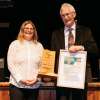
The Gunninghams show how to plant trees for shelter, biodiversity and aesthetics
Posted 26 September 2021
Plantation planning Species, sites and planting Managing trees On-farm benefits Economic benefits and markets Carbon benefits Native regrowth forest management Tree Alliance
Dairying has always been in the blood of fifth-generation family dairy farmers Matthew and Pip Gunningham, owners of Gunningham Family Farms.
Moving from South West England to North West Tasmania over 20 years ago, the couple sought to continue the family business when they fell in love with the area and saw an opportunity to establish a dairy farm in the top corner of the state. Intrigued by the multitude of benefits of trees on farms, Matthew and Pip reached out to Private Forests Tasmania for guidance.
Upon settling into life on the new farm in Montumana, Matthew and Pip noticed that while there was an abundance of previously planted E.nitens and pine species, the trees were scattered throughout the property in various locations.
New to the idea of strategically planting trees to maximise the full potential of the farm and their livestock, the couple made the decision to harvest the established trees to make way for the next generation of trees to be planted.
“The farm seemed extremely bare once it was harvested, we were so used to having trees on our farms,” shares Matthew Gunningham.
Setting a strategy
Seeking the expertise of Private Forests Tasmania, the Gunningham’s settled on re-establishing E.nitens and Radiata Pine plantations - this time in strategic zones across their property that made sense to the location and their farm’s goals. Together, they identified areas for shelterbelts, including on parts of the farm that Matthew would not have previously considered.
“With PFT, we were able to choose the best areas to plant trees based on the areas that were best suited to grazing. We came up with the idea of creating some shelterbelts to help protect our livestock and reap the benefits that trees can have on pasture productivity, evaporation and wind velocity across the paddocks.”
While converting dairy pasture to trees may seem counterintuitive for increasing farm productivity, Matthew explains that in the long run it is the way to go.
“We actually planted trees on previous dairy pasture which was hard to do but we knew it was for the best as we could see the future benefits of having the trees there. We could really start to see the benefits in using shelterbelts on the farm,” says Matthew.

Beauty and Biodiversity
In addition to the intended benefits of the newly planted trees, there are secondary benefits for the Gunningham’s to be excited about. Looking forward to watching the trees develop to enhance the aesthetic beauty of the farm, Matthew also explains that increasing the biodiversity of the farm is top of mind because the farm is a part of a broader ecosystem that needs to be as healthy as possible.
“The biodiversity of the farm is so important to us. The farm is an ecosystem. We believe one of the key outcomes of being involved in this demonstration site project is that the trees will provide more habitat for an abundance of birdlife, and we will have a much more diverse ecosystem on the farm.”
Sharing his learnings with Tasmania’s farmers
While new to tree planting, once becoming aware of the benefits that trees could deliver to his farm, Matthew is now encouraging other Tasmanian farmers to consider doing the same.
“We are thrilled with the help and support we have received. It has been a huge learning experience, but we already know a lot more than we did 12 months prior.”
“I would definitely encourage other farmers to consider planting trees. There would be a lot of farmers who don’t know enough about planting trees strategically (like us), so I would highly recommend a scheme like this,” says Matthew.
“We’re 100% convinced that this is appropriate for lots of farms. We came to get involved in this because we didn’t know the first thing about trees. We can see already where we would apply what we are learning to our other dairy farm and where we would place the shelterbelts.”
Find Gunningham Family Farms on Facebook to follow their progress.







